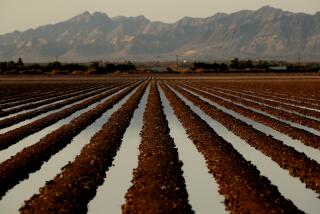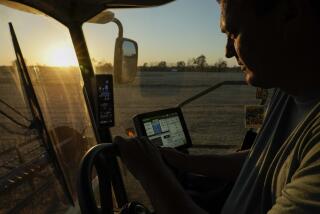Farmers Escape Flooding--but Not Rain : Agriculture: Much of acreage in Missouri and other parts of Midwest are high and dry. But rising water tables pose growing danger to crops.
CAMERON, Mo. — At least 25 miles from the brown edge of the nearest floodwaters, Eldon Mattson squints into the brilliant sunlight of a Missouri afternoon and contemplates a field of withered, yellowing cornstalks. He is sizing up the good luck that has placed him far from the inundated river bottoms, and the bad luck that Mattson reckons will rob him of at least a quarter of his usual harvest anyway.
“Oh, we’re high and dry here as far as the flooding’s concerned. The rain hasn’t flooded us . . . it’s just drowned us,” said the 64-year-old Mattson. “I’ve been farming for 45 years, and this is the worst I’ve ever seen it.”
Mattson’s 1,500 acres of corn, wheat and soybeans are among the 6.5 million acres of Missouri agriculture--roughly three-quarters of the state’s farmland--untouched by rampaging rivers and creeks. But his acreage and many others in Iowa, Nebraska and Kansas are part of a quieter agricultural crisis unfolding far from the floods.
Throughout the Midwest, torrential rains delayed planting by at least a month this season and prevented many farmers from applying fertilizer or herbicide because their heavy farm machinery could not negotiate the sodden fields. Now, thousands of farmers throughout the affected areas are reaping harvests that are diseased, stunted and weed-choked. And for many, the misfortune could continue into next year.
The threat, in Mattson’s case, is literally underground. Rising water tables in the Midwest’s river valleys have soaked the roots of corn, wheat and bean plants and choked off their source of oxygen. Already immature because of plantings delayed by the rain, the roots are slowly succumbing to the waters.
Above the ground, the skies are now brilliantly blue and many fields are still green. But underground, the plants are on the verge of drowning, a condition that will cause them to turn yellow or, in the case of beans, “dampen off” or wither. If they don’t die, experts said, the plants will produce an anemic yield and will remain especially vulnerable to disease for the rest of the planting season.
“I call it wet feet . . . the plants are actually drowning,” said Philip Barnes, an agricultural researcher at Kansas State University in Manhattan, Kan. “A lot of these fields are starting to show stress, and even if it stops raining, I don’t think we’re going to see normal yields. They talk about billions (of dollars) for flooded people. But these farmers stand to lose as much as the people who are flooded.”
The problem is only a little different for farmers whose fields are located in the Midwest’s uplands, the heights that have been protected even from rising water tables. There, rainfall for the last two months has in many cases been six times higher than normal. Sodden topsoil has caused crops like wheat to droop and die, creating a “mat” on the soil that may prevent the ground from drying up even if the skies remain clear. That, said Barnes, could sustain a muddy crisis that will hamper planting as far away as next year.
Fungus and mold are growing wildly in the damp conditions, said Barnes, and reports of usually isolated plant diseases like “crazy top,” which stunts corn, have become widespread, he said. Mattson said that leaf blight has attacked his beans with especial ferocity, and that root disease appears to be widespread among his crops.
According to Daryl Buchholz, assistant director of Kansas State University’s Extension Service, the season’s harvest of low quality hay--a result of the rains as well--will cause farmers to sell off and slaughter cattle early. The result, he said, will be that farmers will be economically hobbled as they go into next year.
“The problems just keep growing,” said Barnes.
Indeed, federal disaster policies are likely to bypass the vast number of these farmers, exacerbating a still-festering economic crisis for the Midwest’s agricultural sector. To become eligible for most federal disaster assistance programs, farmers need to have lost between 35% and 40% of their crops overall. Many--like Mattson--will come in just below that figure.
“In Missouri, for instance, we have a lot of financial problems left over from the farm problems of the 1980s,” said Kyle Vickers, deputy director of the Missouri Department of Agriculture. “We have a lot of farmers hanging on by their fingernails, and this is going to loosen a lot of their grips.”
The full extent of such losses has not been figured into estimates of the region’s flood damage, and will only begin to become evident after the U.S. Department of Agriculture receives its first reports from farmers of crop inventory on July 30.
“These damage numbers could increase then,” said Missouri Agriculture Department spokeswoman Gail Anderson. Currently, Missouri alone has estimated the cost of agricultural damage at almost $1.5 billion.
Karen Dixon, a spokeswoman with the U.S. Department of Agriculture, said the federal government is working to extend disaster-aid programs to farmers that would not, under current regulations, be eligible for them. But Mattson, echoing a view widely shared by agricultural analysts, expressed skepticism that more low-cost loans, or even greater forgiveness of existing loans, will be enough to stem a further hemorrhage of farmers from the business.
“A lot of these farmers don’t need any more loans,” said Mattson. “They can’t even pay the interest on what they have now.”
More to Read
Sign up for Essential California
The most important California stories and recommendations in your inbox every morning.
You may occasionally receive promotional content from the Los Angeles Times.











